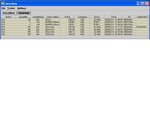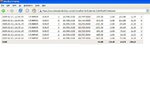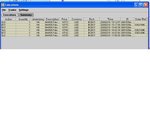Sorry to hear that mate. I went through about three years of that, if it's any consolation. Of course the journey is a very personal issue dependent on one's individual make-up, but I'll mention (mention? more like an outpouring) this anyway, in case it helps:
The turning point came for me when I did/had done the following -
Discarded:
- a lot of "common knowledge" I'd read in books, except for the few gems that fitted well with my personal psychology.
- almost all indicators, except for volume, NYSE TICK and one moving average.
- purely mechanical systems. In fact systems full stop. What one needs is a method that can adapt to different styles of trading day.
- any opinion I might harbour of market direction.
- Studied price action intently for a long time, especially at key levels, e.g is the push towards a level of resistance fast or slow, what is the angle of attack, what happens at the resistance level (is there a fast snapback or a slow choppy pause), do the bars form quickly or slowly (i.e look at the velocity between hi and lo), what sort of volume relative to previous is there, what shape are the bars and where are the closes relative to the opens etc. After a while patterns become if not ingrained, at least sometimes accessible. It is very useful to try and work out why a certain pattern or movement is occuring. If the pros are chucking in size the movement is likely to be fast - what does this tell you? What about when it isn't? The market often shows her hand in advance if you let her. (NB I can only see this about 10% of the time at best 🙂)
Empathy towards the various trading groups (pros, crowd and gamblers, for instance) and what they are feeling and trying to achieve or avoid, coupled with deductive, analytical reasoning can help get into the market as opposed to looking down on it. This I would say is the most important step.
-Let the market decide whether I entered a trade or not. My method calls for low risk high reward entries and these are often provided by someone else's mistakes.
-Discovered and selected a handful of setups, the very few that I had read about or defined for myself that I could spot time and time again, without fail. Either they were there, or they weren't. How did I know if they were there?
Well, in the case of a setup derived from a bar formation, the pattern must conform exactly to a set of mechanical rules. (This does not mean the overall method is mechanical as you will see).
e.g. A 1-2-3 is defined by strict rules, as is a Ross Hook following a 1-2-3 breakout. The bars either confirm it, or they don't.
While, say, a Grail entry requires the price to pull back to an EMA in a trend, a trend which is confirmed by the ADX being >30 (well I kept the odd indicator!).
That's three of which everyone is familiar, there are others which I'd prefer not to mention..
Forget the context of the patterns for the moment, just learn to find them and define them, in black and white. They will become your friends and all else becomes so much less signficant.
It is a matter of concentrating on the detail that the majority ignore or miss.
Once I had defined the patterns I worked out a way to enter. Actually I didn't, in the case of 1-2-3s / Ross Hooks, I shamelessly borrowed an entry technique from Joe Ross, namely the Trader's Trick Entry.
e.g Wait until there is a potential #3 point forming and place a prospective entry one tick above or below this potential #3 bar. If the next bar negates this #3 point without triggering the entry then cancel the order and wait to see what the next bar does. Let the bars decide your actions, don't second guess the market.
Once I did this then I looked at targets and exits with a view to at least paying costs, then making a profit. Studying charts in real time or going back over them bar by bar is a good way to do this. Given a number of past 1-2-3s or Grail entries what is a realistic initial target that I could be pretty sure of hitting with high probability? For me, this works out, at the moment, as around 5 pips, given the 4 minute bar chart I trade off.
So, the setups were defined and when I chose to trade one I knew exactly what to do whatever the market might throw at me. This takes away all the uncertainty that can occur once in a position. The exit is always known.
This makes the penultimate step easier. This step is subjective, the only subjective element of my system. It depends on experience and intuition, which you must learn to trust. A lot of potential setups occur each and every trading day. There may be 2 potential Grail trades, a handful of 1-2-3s and a couple of Ross Hooks. But they're not all worth taking. When I do take them I know what to do, because rhe rules are mechanical. So all I have to use my brain for is deciding whether or not to take them. This depends on context and subjectivity. A 1-2-3 short bang above the EMA, maybe not such a good idea. A Ross Hook pullback long at the top of a huge extended up trend and a century number, maybe not such a good idea. But a 1-2-3 long after a volume climax following a savage downtrend resting at Dow 32, yes, I might take that. Good 123s often have symmetry (e.g an equal # of bars between 1,2 and 3) and clarity of structure too. They "look" right.
The point is I have objective, concrete rules to define my setups and then a subjective element to decide whether to take them or pass on them.
There's nothing wrong with losing a few pips here and there. Tight stops are great for forcing you to choose an entry with precision and patience. Discipline (and believe me discipline has always been my nemesis) is so much easier to enforce when I know what I am supposed to be doing. I no longer care what the market might do as it doesn't matter.
Define some setups, even a mere two is enough. Get to know them inside out. Work out some targets and stops by observing what has happened in the past when these setups occur, also ensuring they square with your money management criteria. Adjust the stops to the bar formations, e.g a tick below the bar that confirms the setup. Fixed stops can waste money. Keep it simple, more simple than I could possibly believe given how many esoteric techniques and clever things I've tried to incorporate over the years (result - failure). And keep an eye on the wider timeframes in case there's something blindingly obvious that says don't take this trade or get out now.
Study the market geometry - if there is a trend is there a likely target for it, e.g a 1:1 measured move with a pullback in the middle. The symnetry can often be amazing, e.g 5 waves up in a 1:1.618:1 or 1:1:1 ratio really clean within a pip or two. Also be aware of pivots and longer time trendlines, obviously.
Finally, position sizing and scaling out. So you've found an entry and a high probabilty target for most of your postion. Good. But why settle for 5 pips with your whole position? (If I did I would be a net loser, no question - the expectancy simply isn't there) So I'll leave a runner or two in, move the stop up or down with each bar's close and try and squeeze as much as I can out of it. If stopped out, no probs, it doesn't matter. I'll be stopped out 50%+ of the time for b/e or +/- a few pips, but sometimes the market will give me 20+ and it must be given a chance to provide this, where possible. I tend to run one running with a tight trail and leave the other much looser.
Sorry for this patronising ramble Q. I know just how you feel and I still have a long way to go, but I'm sure something will click for you. I have to thank Joe Ross for my turnaround. The Law of Charts and the Trader's Trick have made a huge difference, not only to my setups but to my whole view of what trading is about. The first time I read it I discarded it as over complicated and long winded, but it is actually the opposite. The irony could not be thicker. As Soc has said, if it wasn't so serious, it would be funny.
When you have defined, tested setups then discipline ceases to be an issue: you just get on with the job. Sure, some refinement is healthy, indeed necessary from time to time, but the principle still holds true. The other joy of defined setups is it frees one's mind to concentrate passively on the price action, to really get "inside" the market, ot understand a little more of how it is made to work day after day.
This is all off the top of my head. It is all personal, vague and probably will not apply to your preferred style and temperament. I hate trends and like quick high probability results, that's me. I like poker for the same reasons (except with poker I'll lose 9 small stakes and win 1 big pot - quite the opposite in some respects, but the result is still quick 😆)
Because this style suits me I am not tempted to break my rules and my discipline holds true through thick and thin. There's always another trade. But I think there is a principle lurking in there worth taking on board, perhaps. Anyway it is late and I will have to edit tomorrow, but just a flavour of what is going on in Frugi-world. Hope my rambling is of some use Q. Good luck and all the best. 🙂












